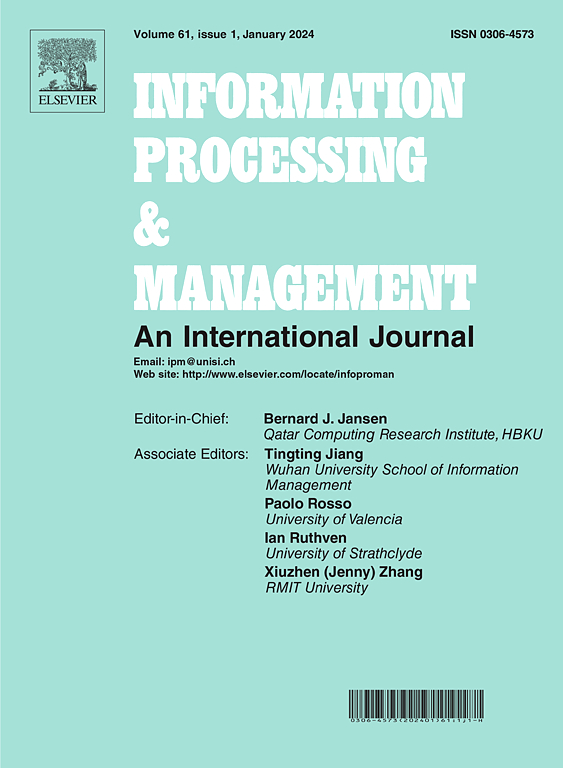PVSTrans: Patch-view-shape progressive interaction transformer for 3D shape recognition
IF 7.4
1区 管理学
Q1 COMPUTER SCIENCE, INFORMATION SYSTEMS
引用次数: 0
Abstract
3D shape recognition has made substantial progress due to its wide-ranging applications and increasing research interest. Existing studies have investigated the paradigm of aggregating 3D shape descriptors derived from independently extracted view features. However, this stepwise approach has not fully capitalized on the intrinsic correlations between local regions of varying granularity and global shapes. To address this gap, we propose the Patch-View-Shape Progressive Interaction Transformer (PVSTrans), which enhances shape-patch interactions through progressive view-patch and shape-view interactions, effectively capturing essential dependencies among intra-view features, inter-view features, and global 3D shape features. Furthermore, by utilizing the byproducts of the progressive interaction process, specifically the attention weights of views and intra-view patches, we introduce a Shape-Guided Patch Selection strategy to dynamically identify significant patches in each view, which in conjunction with the multi-view features, forms a more informative 3D shape descriptors for final classification. Experimental results across diverse datasets, including ModelNet40, ScanObjectNN, FG3D, and ShapeNet Core55, demonstrate the effectiveness and generalizability of PVSTrans in 3D shape recognition tasks. Additionally, comprehensive experiments involving various views with differing quantities and spatial relations highlight the robustness of PVSTrans in handling incomplete views and irregular spatial configurations, showcasing its substantial potential for application in complex real-world scenarios. The code is available on https://github.com/Oli-lab-nun/PVSTrans.
PVSTrans:用于3D形状识别的斑块视图形状渐进交互变压器
三维形状识别由于其广泛的应用和越来越多的研究兴趣而取得了实质性的进展。现有的研究已经研究了由独立提取的视图特征派生的三维形状描述符的聚合范式。然而,这种循序渐进的方法并没有充分利用不同粒度的局部区域和全局形状之间的内在相关性。为了解决这一差距,我们提出了斑块-视图-形状渐进交互转换器(PVSTrans),它通过渐进视图-补丁和形状-视图交互来增强形状-补丁的交互,有效地捕获视图内特征、视图间特征和全局3D形状特征之间的基本依赖关系。此外,通过利用渐进式交互过程的副产品,特别是视图和视图内补丁的关注权,我们引入了形状引导补丁选择策略来动态识别每个视图中的重要补丁,该策略与多视图特征相结合,形成了更有信息量的3D形状描述符,用于最终分类。不同数据集(包括ModelNet40、ScanObjectNN、FG3D和ShapeNet Core55)的实验结果证明了PVSTrans在3D形状识别任务中的有效性和通用性。此外,涉及不同数量和空间关系的各种视图的综合实验强调了PVSTrans在处理不完整视图和不规则空间配置方面的鲁棒性,展示了其在复杂现实场景中的巨大应用潜力。代码可在https://github.com/Oli-lab-nun/PVSTrans上获得。
本文章由计算机程序翻译,如有差异,请以英文原文为准。
求助全文
约1分钟内获得全文
求助全文
来源期刊

Information Processing & Management
工程技术-计算机:信息系统
CiteScore
17.00
自引率
11.60%
发文量
276
审稿时长
39 days
期刊介绍:
Information Processing and Management is dedicated to publishing cutting-edge original research at the convergence of computing and information science. Our scope encompasses theory, methods, and applications across various domains, including advertising, business, health, information science, information technology marketing, and social computing.
We aim to cater to the interests of both primary researchers and practitioners by offering an effective platform for the timely dissemination of advanced and topical issues in this interdisciplinary field. The journal places particular emphasis on original research articles, research survey articles, research method articles, and articles addressing critical applications of research. Join us in advancing knowledge and innovation at the intersection of computing and information science.
 求助内容:
求助内容: 应助结果提醒方式:
应助结果提醒方式:


